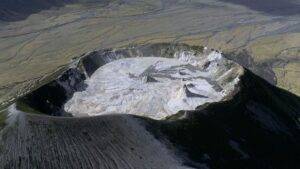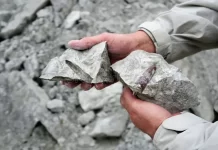
Table of Contents
ToggleIntroduction
Tucked away in the heart of Tanzania lies one of the most fascinating and unusual volcanoes on Earth—Ol Doinyo Lengai, often referred to as the “Mountain of God” by the local Maasai people. Unlike most volcanoes, this enigmatic mountain possesses characteristics that set it apart from the rest of the world’s volcanoes. Known for its rare carbonatite lava, which is cooler and flows faster than the usual silica-rich lava, Ol Doinyo Lengai offers a unique geological wonder that has baffled and intrigued scientists for decades.
In this article, we will explore what makes the Mountain of God so weird, from its unusual lava composition to its remarkable geological history. Let’s dive deep into the bizarre and awe-inspiring nature of this one-of-a-kind volcanic marvel.
Table of Contents
- Location and Cultural Significance
- Geography of Ol Doinyo Lengai
- The Maasai and the “Mountain of God”
- Unique Features of Ol Doinyo Lengai
- Carbonatite Lava: The Key to Its Uniqueness
- Cooling Temperatures and Fast Flowing Lava
- Eruptions and Activity
- Recent Eruptions
- The Lava Fountain Phenomenon
- Why Is Ol Doinyo Lengai Considered the Weirdest Volcano?
- Uncommon Lava Composition
- Unpredictable Eruptions
- Formation of Unique Landscapes
- FAQ Section
1. Location and Cultural Significance
Geography of Ol Doinyo Lengai
Ol Doinyo Lengai is located in northern Tanzania, near the eastern branch of the East African Rift Valley. It sits about 120 kilometers northwest of Arusha and is relatively close to the iconic Serengeti and Ngorongoro Crater. Towering at about 2,962 meters (9,718 feet), this active volcano overlooks the stunning landscape of the surrounding region, including the Lake Natron basin, known for its extreme alkalinity and flamingo populations.
The Maasai and the “Mountain of God”
The local Maasai people have revered Ol Doinyo Lengai for centuries, referring to it as the “Mountain of God” due to its mystical presence and the raw power of its eruptions. The Maasai hold the belief that the volcano is a sacred place where their deity resides, and as such, the mountain has immense spiritual significance. The unpredictable eruptions, rare lava, and its towering presence in the East African landscape have only added to its mythic status in the region.
2. Unique Features of Ol Doinyo Lengai
Carbonatite Lava: The Key to Its Uniqueness
The most striking feature that makes Ol Doinyo Lengai stand out is its carbonatite lava. Unlike typical lava, which is rich in silicate minerals and is extremely hot (about 1,000°C or more), the lava that flows from this volcano is unusually cool, with temperatures between 500°C and 600°C. It is the only active volcano in the world known to produce natrocarbonatite lava, a rare type of lava that contains sodium and potassium carbonate minerals.
Cooling Temperatures and Fast Flowing Lava
Because of its relatively low temperatures, carbonatite lava is much more fluid than silicate lava. It moves quickly, often resembling flowing mud rather than the sluggish movement of typical lava flows. Its dark, blackish-brown appearance when it emerges soon turns white as it cools due to the rapid weathering of its unique chemical composition. This rapid transition is caused by its reaction with moisture and CO2 in the atmosphere, resulting in the formation of white sodium carbonate crusts.
3. Eruptions and Activity
Recent Eruptions
Ol Doinyo Lengai has had a long history of volcanic activity, with eruptions recorded as far back as 1883. While many of its eruptions have been relatively small, larger and more violent eruptions have occurred as well, the most notable being in 2007-2008, when it released an explosive amount of carbonatite lava, along with ash plumes that rose as high as 15 kilometers into the atmosphere.
Its eruptions often alternate between effusive eruptions—where lava flows smoothly out of the crater—and explosive eruptions, where ash and rock are ejected. However, these transitions are highly unpredictable, adding to its mystique and reputation as one of the weirdest volcanoes in the world.
The Lava Fountain Phenomenon
Another bizarre feature of the Mountain of God is its lava fountains. Unlike the usual fiery displays seen in silicate-based volcanoes, the lava fountains at Ol Doinyo Lengai are much less violent, spewing black carbonatite lava that cools rapidly into fragile, needle-like formations. These formations are so delicate that they can disintegrate into fine powder with just a light touch.
4. Why Is Ol Doinyo Lengai Considered the Weirdest Volcano?
Uncommon Lava Composition
What truly sets Ol Doinyo Lengai apart is its natrocarbonatite lava, a geological oddity not found in any other active volcano on Earth. This rare type of lava is rich in sodium and potassium carbonates, which is a stark contrast to the silicate-rich lava produced by most volcanoes. Its chemical composition also causes it to react unusually fast with the atmosphere, creating the striking white crust on the cooled lava.
Unpredictable Eruptions
Ol Doinyo Lengai’s unpredictability further fuels its reputation as one of the weirdest volcanoes. While most volcanoes have eruption patterns that can be studied and forecasted, Ol Doinyo Lengai remains somewhat enigmatic in its behavior. It alternates between calm lava flows and sudden explosive eruptions, often without warning.
Formation of Unique Landscapes
The interaction between the alkaline lava and the surrounding environment leads to the formation of striking landscapes. Over time, the carbonatite lava creates otherworldly volcanic cones, lava plateaus, and caverns. The rapid weathering of the lava also contributes to the fertility of the surrounding soil, making the region home to unique plant species that thrive in the area’s rich volcanic ash.
5. FAQ Section
1. Why is Ol Doinyo Lengai called the “Mountain of God”?
The name comes from the local Maasai people, who have long believed that the mountain is the dwelling place of their deity. It holds spiritual significance due to its awe-inspiring eruptions and towering presence over the Tanzanian landscape.
2. What makes carbonatite lava so unique?
Carbonatite lava is rich in sodium and potassium carbonates, unlike typical silicate lava. It is much cooler, flows faster, and reacts quickly with the atmosphere to form a white crust as it cools, a process that makes it visually striking and geologically rare.
3. How often does Ol Doinyo Lengai erupt?
Ol Doinyo Lengai erupts frequently, with minor eruptions occurring regularly. Larger, more explosive eruptions are less frequent but have been recorded throughout its history. Its most recent significant eruption was in 2007-2008.
4. Can you visit the Mountain of God?
Yes, adventurous travelers and geologists often visit the region, and it has become a popular site for hikers and volcano enthusiasts. However, the climb is challenging, and safety precautions must be taken, especially considering the volcano’s unpredictable nature.
5. Is Ol Doinyo Lengai dangerous?
While Ol Doinyo Lengai’s eruptions are typically less violent than other volcanoes, it can still pose a threat due to its unpredictable eruptions. The volcanic gases and ash plumes can also affect air quality and visibility in the surrounding areas.
Conclusion
Ol Doinyo Lengai, the “Mountain of God,” is a geological marvel unlike any other. Its carbonatite lava, unpredictable eruptions, and spiritual significance make it one of the most mysterious and fascinating volcanoes in the world. Whether viewed from a scientific perspective or revered for its cultural importance, Ol Doinyo Lengai remains a symbol of the Earth’s powerful and unpredictable forces. As the only active volcano producing natrocarbonatite lava, it holds a unique place in the world of volcanology and continues to captivate the imagination of all who encounter it.










